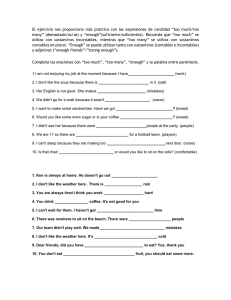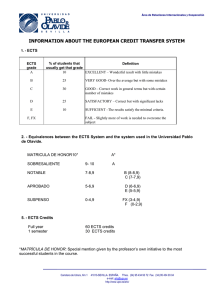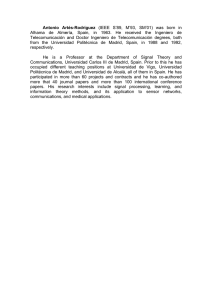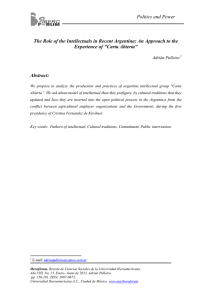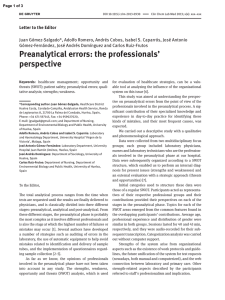Revista fin - Universidad de Granada
Anuncio
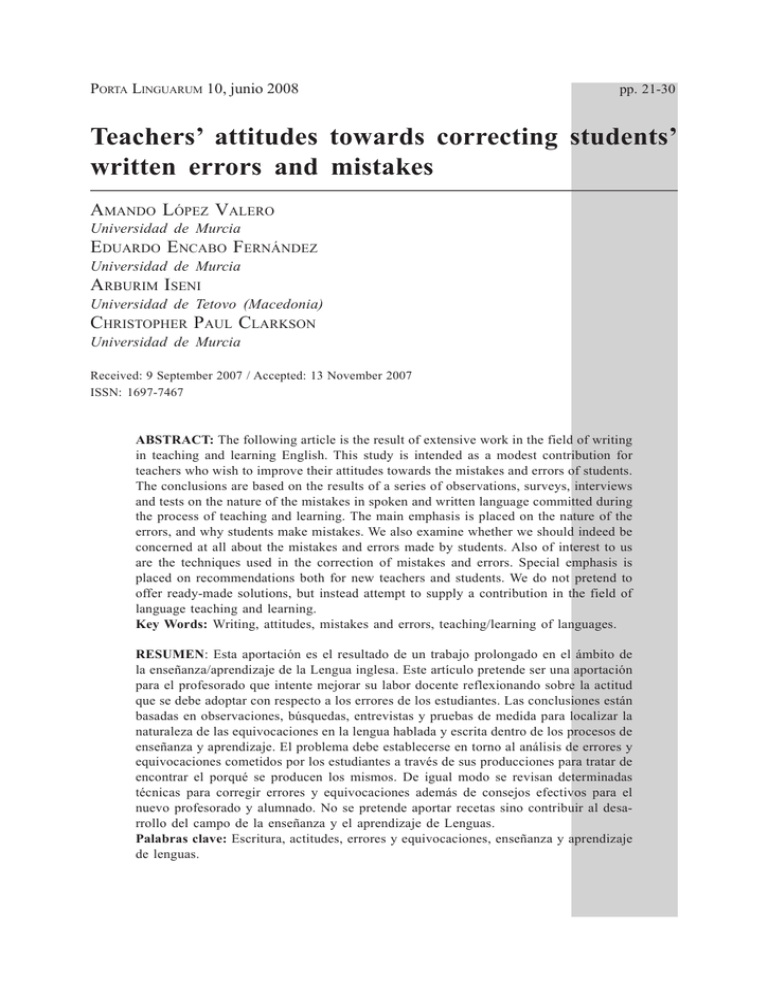
SANDRA IGUEIREDO10, junio 2008 P ORTA LF INGUARUM The psychosocial predisposition effects in pp. second ... 21-30 Teachers’ attitudes towards correcting students’ written errors and mistakes AMANDO LÓPEZ VALERO Universidad de Murcia EDUARDO ENCABO FERNÁNDEZ Universidad de Murcia ARBURIM ISENI Universidad de Tetovo (Macedonia) CHRISTOPHER PAUL CLARKSON Universidad de Murcia Received: 9 September 2007 / Accepted: 13 November 2007 ISSN: 1697-7467 ABSTRACT: The following article is the result of extensive work in the field of writing in teaching and learning English. This study is intended as a modest contribution for teachers who wish to improve their attitudes towards the mistakes and errors of students. The conclusions are based on the results of a series of observations, surveys, interviews and tests on the nature of the mistakes in spoken and written language committed during the process of teaching and learning. The main emphasis is placed on the nature of the errors, and why students make mistakes. We also examine whether we should indeed be concerned at all about the mistakes and errors made by students. Also of interest to us are the techniques used in the correction of mistakes and errors. Special emphasis is placed on recommendations both for new teachers and students. We do not pretend to offer ready-made solutions, but instead attempt to supply a contribution in the field of language teaching and learning. Key Words: Writing, attitudes, mistakes and errors, teaching/learning of languages. RESUMEN: Esta aportación es el resultado de un trabajo prolongado en el ámbito de la enseñanza/aprendizaje de la Lengua inglesa. Este artículo pretende ser una aportación para el profesorado que intente mejorar su labor docente reflexionando sobre la actitud que se debe adoptar con respecto a los errores de los estudiantes. Las conclusiones están basadas en observaciones, búsquedas, entrevistas y pruebas de medida para localizar la naturaleza de las equivocaciones en la lengua hablada y escrita dentro de los procesos de enseñanza y aprendizaje. El problema debe establecerse en torno al análisis de errores y equivocaciones cometidos por los estudiantes a través de sus producciones para tratar de encontrar el porqué se producen los mismos. De igual modo se revisan determinadas técnicas para corregir errores y equivocaciones además de consejos efectivos para el nuevo profesorado y alumnado. No se pretende aportar recetas sino contribuir al desarrollo del campo de la enseñanza y el aprendizaje de Lenguas. Palabras clave: Escritura, actitudes, errores y equivocaciones, enseñanza y aprendizaje de lenguas. 21 PORTA LINGUARUM Nº 10, junio 2008 1. INTRODUCTION We propose that social conditions in general are not in accordance with educational performance in schools. This is due to the fact that the speed of social change demands learning based on the acquisition of skills rather than on factual knowledge. This means that links between the social environment and the work carried out in schools should necessarily be strengthened. Unavoidably, schools increasingly exist in a context defined by the market, an institutionalised management, and a bureaucratised curriculum (Giddens, 1990). As a result a failure to modernize teaching strategies and bring them in line with up-to-date methodologies, could cause schools to become isolated islands within the social framework. Consequently, there is a very real need to take issue with the relationship between the two skills of reading and writing, since doing so will allow us to reach a better understanding of the complexity of this relationship within the social setting (Heller, 1999). What is called for, therefore is a change in attitude and a move towards lifelong learning: in other words, an education in competence. Simply training students is not enough. There should be a move beyond this, towards encouraging individuals to use their own initiative so that their progress develops in parallel to that of society. This aspect will be dealt with in greater detail when we refer specifically to language teaching (Richards, 1998). The key concept associated with lifelong learning should be that of communicative competence. This can be defined as the knowledge required by the speaker to communicate effectively in culturally meaningful contexts (Hymes, 1971). If we can utilize this idea effectively we will almost certainly be closer to forming competent individuals capable of performing successfully in different social contexts. This idea will be taken up again later when we discuss integrated language learning. If we are to educate learners in skill development it will become evident that some sort of transformation is necessary, a transition from a purely rational model to a critical paradigm of teaching which serves as a framework for our performance in schools. What is needed are critical intellectuals capable of transforming social and educational reality (Kaplan, 2000). In this article, we intend to discuss the topic of mistakes and errors within the context of these previously mentioned theories. We consider that teaching using these methodologies will promote a more communicative environment. 2. THEORETICAL FRAMEWORK CONCERNING MISTAKES AND ERRORS The field of error analysis in Second Language Acquisition was established in the 1970s by S. P. Corder and colleagues. Error analysis was an alternative to contrastive analysis, an approach influenced by behaviourism, through which applied linguists sought to use the formal distinctions between learners’ first and second languages to predict errors. Error analysis showed that contrastive analysis was unable to predict the great majority of errors, although the more valuable aspects have been incorporated into the study of language transfer. A key finding of error analysis has been that many learner errors are produced by learners making faulty inferences about the rules of the new language. There are several studies concerning the topic of this article. For example, in Spain, it is dealt with in the doctoral theses of Roca de Larios (2000), Gutiérrez Toledo (2001), 22 AMANDO LÓPEZ, EDUARDO ENCABO et al. Teachers’ attitudes towards correcting students’ ... Hernández Fernández (2001), Colwell (2004) and Cabrejas (2006). All of these study aspects of errors and mistakes. We should also mention other important studies such as Bueno, Linde and Carini (1992), Linde (1991) or the important work by Brown (2000) Principles of language learning and teaching (specifically chapter eight), which contains a widely-available survey of errors and mistakes. Exactly why students make mistakes and errors, should be a concern for both teachers and students. How should these be corrected? How should the analysis of these errors be carried out? These issues cannot be covered within one article. We cannot even give fully comprehensive answers. In this article we will try to offer suggestions which have been formulated through extensive study and experience in the field of applied linguistics. These conclusions are the outcomes of our observations, interviews and research, as well as the personal experiences of teachers. In this article the emphasis will be on the techniques which teachers may use in correcting the errors of their students as well as strategies to prevent their repetition. Teachers usually encounter two problems while correcting mistakes and errors. Firstly they must find the cause of the mistake or error. Secondly they must devise techniques by which they can effectively interact with the student in correcting their errors. Thirdly they must also evolve strategies to ensure their students do not repeat these errors Generally, even today teachers still deal with the first issue rather than with the second. 2.1. What is a mistake and what is an error? There has always been a generally accepted concept that if you break grammatical or structural rules you have made a mistake. Grammatical problems still remain, but today attention is moving more towards a broader concept, in the form of the vocalizing of ideas. In addition, there is more emphasis nowadays on discovering the real causes of the mistakes and errors and ways of correcting and avoiding them. A mistake is something natural, something that the teacher may identify, treat or ignore. It is their decision. Pit Corder (1991) stated “A mistake is not an issue of knowledge, but it is an issue of its application”. Error analysts distinguish between errors, which are systematic, and mistakes, which are not. They often seek to develop a typology of errors. Error can be classified according to basic type: emissive, additive, substitutive or related to word order. They can be classified by how apparent they are. Overt errors such as «I angry» are obvious even out of context, whereas covert errors are evident only in context. Closely related to this is the classification according to domain, the breadth of context which the analyst must examine, and extent, the breadth of the utterance which must be changed in order to correct the error. Errors may also be classified according to the level of language: phonological errors, vocabulary or lexical errors, syntactic errors, and so on. They may be assessed according to the degree to which they interfere with communication. Global errors cause an utterance to be difficult to understand, while local errors do not. In the above example, «I angry» would be a local error, since the meaning is apparent. 23 PORTA LINGUARUM Nº 10, junio 2008 Error analysis is closely related to the study of error treatment in language teaching. Today, the study of errors is particularly relevant to the methodologies of teaching. 2.2. Why do students make mistakes and errors? This concern still remains at the roots of developments in methodology. Mistakes and errors may be caused because of: a) Ignorance, of not knowing the rules, the structure of the language, and so on. b) The inability of students to apply what they have learned. The behaviourist approach treats the mistake and the error as a symptom of non-effective teaching, as proof of failure. The mentalist attitude considers mistakes and errors as proof that the student is learning. The student learns even more from mistakes and errors when they are carefully corrected. 2.3. Should mistakes and errors concern us? The simple answer to this is: Of course they should, for two reasons: Firstly, they are direct proof of what students know and what they don’t know. Secondly, mistakes and errors are symptomatic of any problems that students may have. From the beginning, error analysis was beset with methodological problems. In particular, the above typologies are problematic: from linguistic data alone, it is often impossible to reliably determine what kind of error a learner is making. Also, error analysis can deal effectively only with learner production (speaking and writing) and not with learner reception (listening and reading). Furthermore, it cannot control use of communicative strategies such as avoidance, in which learners simply do not use a form with which they are uncomfortable. For these reasons, although error analysis is still used to investigate specific questions in second language acquisition, the quest for an universal theory of learner errors has largely been abandoned. In the mid-1970s, Corder and others moved on to a more wide-ranging approach to learner language, known as interlingua. 2.4. How should mistakes and errors be corrected? While mistakes in spoken language may be allowed without being corrected since the message can normally be understood with the help of non verbal cues and signals, errors must be corrected more carefully in written language because if they are left uncorrected they become fossilized. Therefore, it is very important to find a suitable strategy for the correction of errors. Mistakes and errors must not be routinely left uncorrected. Students must be informed of their mistakes and errors, and they must constantly be updated on their learning development. Positive analysis of mistakes and errors encourages the student to progress and does not intimidate or worry them. We should pay great attention to teaching our students to recognise their mistakes and errors themselves, correct them, and analyze them, which leads naturally to a greater understanding and more profound self-evaluation of their work. This positive analysis cannot evolve if the teacher does not practise this procedure, and if students likewise do not become accustomed to the resulting self-evaluation. There will be times when the teachers want the students to correct their own work. It is better if students check their errors in pairs or in small groups and try to identify any error and then consult the teacher. This is 24 AMANDO LÓPEZ, EDUARDO ENCABO et al. Teachers’ attitudes towards correcting students’ ... done so that the students can learn to see their work critically, while it is still uncorrected by the teacher. Naturally this procedure will not be suitable in all instances, but will at least help students to be able to check and self-correct any given work. 3. ANALYSIS OF ERRORS AND MISTAKES Work is more valuable when mistakes and errors are analyzed. It is useful to find general mistakes and errors, so that after careful analysis the mistakes and errors are not repeated. An analysis of mistakes and errors enables teachers to identify a student’s shortcomings and needs. An analysis through contrast may serve as a powerful pedagogical tool by saving time and effort for both the teachers and students. An analysis of the mistakes and errors: – Reveals any general deficiencies and weaknesses that the students have; – Highlights words, utterances and structures that prove to be difficult at a particular stage of development; – Highlights gaps in student knowledge. – Helps the teacher to identify abstract fields where his teaching has not been effective. – May lead towards a correction of teaching methods. – Accumulates a wealth of data for the teacher’s training and his teaching material in the future. An analysis of mistakes and errors may also show fields where study-research activity should be concentrated in the future. To be able to better analyse mistakes and errors the teacher should possess: – An in-depth knowledge of the area being taught – High proficiency in their mother tongue – Ample experience of the teaching process – An appreciation of the psychological conditions of their students According to surveys, the teacher, after returning the exam papers, generally speaks about the mistakes and errors made by the students, and merely supplies some corrections. This method is not ideal because students are often primarily concerned about their grades and so are not concerned about specific mistakes and errors they make, nor do they discuss the causes of these mistakes and consequently how to correct them. The tight time-frame of the curriculum and the subject syllabus is also a contributing factor here. The teacher should spend at least 10 to 15 minutes with the students on the analysis of the mistakes and errors, especially when the exam papers are distributed to the students or before an exam, so that the students may be able to recognize their mistakes and errors and then consider any corrections. In these sessions of 10 to 15 minutes the teacher can identify any specific or general needs of the students. These needs may later be grouped according to the nature of the mistakes and errors made and the students can discuss them in pairs or in larger groups. When students work together in groups, they are cooperating and actively considering their work, rather than passively listening to the teacher’s analysis. Grouping students together in this way ensures a thorough diagnosis of mistakes and errors. It facilitates the teacher’s work in giving necessary guidelines and it helps students correct their own mistakes and errors as well as those of their class mates. 25 PORTA LINGUARUM Nº 10, junio 2008 In these groups, a student from one group may help in correcting the mistakes and errors of another group. Flexibility and the active participation in the correction process on the part of the individual are clear advantages for this method of examining minor mistakes and errors. The 10 to 15 minutes put aside for this process are of great value. Many issues are treated using group work, and the message of the teacher is more apparent than any written comments in special notebooks, which are read only by the student. 4. COMMENTS ON WRITTEN WORK Writing a comment is a very important moment in the teaching process and especially in correcting mistakes and errors. A teacher’s comment on a piece of written work by the student must be understandable and clear, with clear phrasing and a full explanation, and not simply a grade. Traditionally, grading is done solely by marks. There are cases, however when the assessment is made by written comment., by writing a note in the free space of the text without being further commented on or discussed. The writing of comments in the free space across the text is done for the purpose of assessment and study, to inform the student which exercise has been done well or badly, and to show where the most common difficulties are. Appropriate written comments have considerable value. In order to correct effectively, the teacher must make the aim of the written task clear to the students from the beginning and also where the focus of assessment and correction will be. When the students realize that their work will be carefully corrected, they will take this work more seriously. This is also reflected in their homework. If they realize that correction of their work is done without adequate care or attention they will in turn react correspondingly. It is accepted that the writing of comments is difficult. It requires much work and is time consuming. However, the writing of comments is undeniably valuable and stimulates students to correct and improve. Examples of such comments may be, for example: Your improvement is apparent.... your ideas are good.... be careful with the sentence structure....., your writing has great value especially your use of vocabulary...... I especially like your handwriting..... and what did you want to say with…? how could you better use this…? All these comments encourage the students to analyse their work more enthusiastically. Occasionally, however, there are also teachers who overuse the writing of comments. Writing endless comments can cause the student to become alienated from the teaching process and disillusioned with their work. They may not want to examine their work, discuss it or speak about correcting it. We therefore recommend that the comments are stimulating and concrete. Mistake and error correction as well as written commentary, even though done outside the classroom, is still an integral part of the teaching process. 26 AMANDO LÓPEZ, EDUARDO ENCABO et al. Teachers’ attitudes towards correcting students’ ... There is a definite relationship between correcting mistakes and errors in the classroom, and in the students’ workbooks. Students must understand how assessment is carried out and be praised by the teachers for their correct answers. They must feel free to make mistakes and errors so that they can correct themselves without fear of being punished. The teacher must bear the following in mind: Firstly, understand and think that you are an educator, and not simply a judge who passes judgment on the student’s work. Every note that is written on the student’s paper must represent an opportunity for the student to learn something. Secondly, you must balance your comments. There must be an appropriate amount of positive comments on those areas the student needs to improve in. This is not always easily done, especially when we reach the end of the paper and out of tiredness, the teacher takes the red pen and simply concentrates on mistakes and errors while overlooking the positive elements in the students’ papers. Therefore, the teacher is advised to maintain the required balance.. “Nothing ruins the student’s credibility, except humiliating comments, offences, continual and boring correction” (Corder, 1991). Thirdly, delegate responsibility. Students need to write to develop. The teacher should not think that they are the only reader, and they should correct their students’ work accordingly. They should give students an opportunity to correct each other’s papers and share the responsibility for correction. This can save the teacher’s time, help the students to become effective and independent analyzers of their own work, and cause them to develop a critical attitude towards the work of their classmates. There are various ways to realize this. 5. TECHNIQUES THAT MAY BE USED TO CORRECT MISTAKES AND ERRORS Teaching language and literature using a communicative model involves an important change of mentality with respect to educational structures, because it gives more importance to development of linguistic skills rather than testing academic knowledge (Widdowson, 1978). We have to create activities that involve a functional use of language, and during workshops we should have discussions, mass-media analyses, and so on. The following suggestions can be used with students in order to correct mistakes and errors: a. The correction of all mistakes and errors This is the traditional procedure for the correction of students’ writing. Although it is traditionally used, it is unclear how effective this form of correction is. Some students do not learn anything from the red marks in their notebooks and ignore them. Another important aspect is to correct the students’ notebooks within a short period of time, when everything is still fresh in their mind. We think that there is no effect if their notebooks are corrected after a long period of time. The effect of the correction is lost, and to some extent what is written is forgotten. Problems are common. On the one hand, teachers are required to correct as much as they can, on the other hand it has to be done as quickly as possible. 27 PORTA LINGUARUM Nº 10, junio 2008 Pressure of time obliges teachers to do their work badly and this has an adverse effect on the value of any correction, especially of their homework. b. The correction of all mistakes and errors by selection This procedure presupposes that the teachers should not correct all the mistakes and errors in a student’s paper, but only in those specific areas on which the teacher has decided to focus his attention. Of course, this procedure has positive advantages over total correction. It is more practical and contains clearer objectives for the correction of written work. c. The correction of all mistakes and errors by signs This procedure requires the codes to be clear for the students, Sp – spelling mistake, Gr – grammatical mistake, L – lexical mistake, St – structural mistake, and so on. By using these codes, students become able to work individually and in pairs, and start identifying and analysing their own mistakes and errors. If they cannot do this, they will consult the teacher. This procedure causes students to become more aware of the kind of error they have made and thus they may self correct. Involving students in the correction of mistakes and errors means this procedure should be carried out in a series of progressive stages: First stage: Underline the mistake or error and write its symbol in the empty space above the line. Second stage: Underline the code but do not write the code. Third stage: Write the appropriate code in the margin of the page, but do not say where the mistake or error is on the page. Fourth stage: Put a cross alongside the paper and put as many crosses as there are mistakes or errors. This diversity makes correction more interesting and it stimulates student involvement. d. The teacher may write in the notebook of the students that they must ask the teacher about the mistakes or errors made. This may be used as an alternative to procedures b and c mentioned above. e. Explanation of mistakes and errors – this procedure takes place through comments, such as drawing attention to repeated mistakes or errors, when the teacher has more time to discuss the mistakes or errors in the classroom or when the teacher uses the mistake or error to correct and improve their work and their student’s work in the future. 5.1. Advice for teachers and students – Sit down and correct without any hesitation, don’t work within time constraints – Concentrate on the main issues so that you can help students with written work that may come later – Give students a chance to ask about the written work – Give students a chance to ask about the written comments – If possible comments should be discussed with them – Change the code of correction according to their level and course progress (beginning of the semester and end of the semester) 28 AMANDO LÓPEZ, EDUARDO ENCABO et al. Teachers’ attitudes towards correcting students’ ... – – – – – Change the correction procedures according to the criteria stated above Prepare the students before they start writing Focus on one or two issues that you may think are most important. Offer students comments and concrete and specific suggestions. Be careful when giving comments as they must be positive, since it is always possible to comment positively on their work – Ensure that the student’s work looks neat after correction – Do not write over the student’s work – Use a pen with another colour rather than red as students may be intimidated. 6. CONCLUDING REMARKS In this section, we shall present a brief summary of some aspects that we have highlighted within the text. We have emphasized the nature of mistakes and errors and why students make mistakes and errors. Naturally we have taken into account the lifelong learning philosophy and new trends in language learning. We have tried to give new teachers and students some practical advice so that they can more easily teach English grammar and, particularly the topic of errors and mistakes. We conclude this contribution with an outline of the main ideas in this text: – Teachers must find the cause of the mistakes and errors. They must find a way to interfere and correct those mistakes and errors and also consider what actions should be undertaken to help their students to avoid these mistakes and errors in the future. – Mistakes and errors deeply concern us because they are direct evidence of what students know and what they do not. Mistakes and errors also show us the problems students may have. – While in a spoken language mistakes may be allowed without being corrected since the message can be understood, in written language errors must be corrected more carefully because if they are left uncorrected they get fossilized. It is very important to find a suitable strategy in order to correct them. – It is a good strategy to find general mistakes and errors, and after a careful analysis not allow them to be repeated again. – Teaching language and literature using a communicative model involves an important change of mentality with respect to educational structures, because it places more importance on the development of linguistic skills rather than testing academic knowledge. – We have to create activities that involve a functional use of language. We should implement them during workshops through discussions, mass-media analyses and similar procedures. 7. REFERENCES BARTHOLOMAE, D. (1980). “Study of error”. College Composition and Communication, 31: 253269. 29 PORTA LINGUARUM Nº 10, junio 2008 BROWN, H. D. (2000). Principles of language learning and teaching (4th Ed.). White Plains, NY: Longman. BUENO, A., LINDE, A. y CARINI, J. A. (1992). Análisis de errores en inglés: tres casos prácticos. Granada: Servicio de Publicaciones de la Universidad. CABREJAS, A. B. (2006). A comparison of the revising processes of Spanish Speakers and English native writers: similarities and differences. Universidad de Valencia. Tesis Doctoral. COLWELL, V. (2004). Learner centred error analysis in the EFL writing class. Universidad de León. Tesis doctoral. CORDER, S. P. (1991): Error Analysis and Interlanguage. Oxford: Oxford University Press. GIDDENS, A. (1990). The consequences of Modernity. Cambridge: Polity Press. GUTIÉRREZ TOLEDO, F. (2001). Errores léxico-semánticos en la producción escrita cometidos durante el proceso de adquisición del inglés como L2. Universidad de Salamanca. Tesis doctoral. HELLER, M. F. (1999). Reading-writing connections. From theory to practice. London: Lawrence Erlbaum Associates. HERNÁNDEZ FERNÁNDEZ, A. (2001). Los errores lingüísticos: tipología y necesidad. Universidad de Granada. Tesis Doctoral. HULL, G. (1985). “Research on error and correction”. In B. McClelland & T. Donovan (Eds.). Perspectives on research and scholarship in composition. New York: The Modern Language Association of America págs 162-184. HYMES, D. (1971). On communicative competence. Philadelphia: University of Pennsylvania Press. ISENI, A. (2006): An Analysis of Errors in Albanian Speakers’ English Writings, Master Degree Topic, University of Prishtina, Kosova (Not published). JAMES, C. (1998). Errors in Language Learning and Use: Exploring Error Analysis. London: Longman. JOHNSON, K. (1988). “Mistake Correction”. ELT Journal, 42 (2): 89-96. KAPLAN, A. (2000). “Teacher and student: designing a democratic relationship”. Journal of Curriculum Studies, 32 (3), 377-402. KOTTLER, E. and KOTTLER, J. (2002). Children with limited English: Teaching Strategies for the Regular Classroom. Oaks, California: Corwin Press. LINDE, A. (1991). Análisis de errores en las formas verbales inglesas en la producción escrita realizados por alumnos de la Universidad de Granada. Granada: Servicio de Publicaciones, Universidad. RADECKI, P. and SWALES, J. (1988). “ESL student reaction to written comments on their written work”. System, 16: 355-365. RICHARDS, J. (1970). “A non-contrastive approach to error analysis”. Paper presented at the TESOL Convention, San Francisco. RICHARDS, J. C. (1998). Beyond training. Perspectives on Language Teacher Education. Cambridge: University Press. ROCA DE LARIOS, J. (2000). Cognitive processes in L1 and L2 writing: a cross-sectional study. Universidad de Murcia. Tesis doctoral. SHAUGHNESSY, M. (1977). Errors and expectations. New York: Oxford University Press. WIDDOWSON, H. G. (1978). Teaching language as communication. Oxford: Oxford University Press. WINDSOR, B. D. (1974). All what I was taught, and other mistakes: a handbook of common errors in English. Oxford: Oxford University Press. 30
